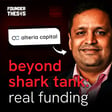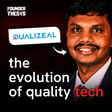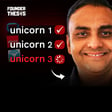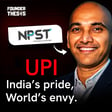Become a Creator today!Start creating today - Share your story with the world!
Start for free
00:00:00
00:00:01

Empowering founders with debt | Eklavya Gupta @ Recur Club
Recur Club is solving the problem of access to funds for startups with predictable revenue streams. Their secret sauce lies in the deep tech integration that they are able to do with the borrowers.
Additional links:-
1. Recur Club allocates $15 million in financing to Indian start-up founders affected by SVB crisis
2.Most Companies Die Because They Don’t Get Capital At Right Point: Recur Club Founder
Transcript
Introduction to Record Club
00:00:00
Speaker
Hi everyone, I'm Iglav Igupta, founder and CEO of Record Club. It's a fintech platform facilitating non-dilutive growth capital for companies with predictable record revenues.
00:00:22
Speaker
It is a well-known fact that 90% of all start-ups fail. But a more interesting statistic is that only 10% of the start-ups fail in the first year and 80% of them fail after the first year. And one of the most common reasons is lack of funds.
Record Club's Mission: An Interview with Ekla Vyaguptha
00:00:36
Speaker
In this episode of the Founder Thesis Podcast, your host Akshay Dutt talks to Ekla Vyaguptha, the co-founder of Reco Club.
00:00:43
Speaker
Record Club is on a mission to solve the problem of access to funds for startups with predictable revenue streams. Traditionally, banks and NBFCs don't lend to loss-making startups. But Record Club is able to lend to even loss-making startups, which have a recurring subscription revenue. Their secret sauce is in the deep-tech integration that they are able to do with the borrowers, which allows them to get better data for credit scoring and get high-velocity repayments.
00:01:08
Speaker
Stay tuned and subscribe to the Founder thesis podcast on any audio streaming platform to learn about disrupting traditional business practices by making use of technology�
Ekla's Journey in Finance and Engineering
00:01:25
Speaker
You know, I just developed a great interest in both those fields. And I think that led me to do engineering from Delhi, from an SIT in Delhi. And when I went there, all the lives I loved engineering and then I realized, oh, it's probably finance. Right.
00:01:40
Speaker
I was up to Lehman crash in 2008 and that time I was in middle of my undergrad engineering days. That started peaking my interest in finance to understand what's happening that is shaking the entire world etc. And finance is also numbers at least at the basic level till you go deep into it. So I really liked it from get-go and I think that was the journey that I took. And post undergrad actually I joined a financial investment firm called Amuroid. It was an investment bank.
00:02:06
Speaker
This is a Japanese investment bank. That's correct. Yes. So I joined their office in Mumbai. Navura, what was your role? So in Navura, I was working as a trader, a support role. I was basically in the global capital market where I was working on structured credit transactions, working on pricing, valuations, modeling of trades that were to happen.
00:02:28
Speaker
was primarily working with the back anemia regions that Europe banned primarily with a lot of traders actively to bright and value their trades. Great experience I think because Nomura had just bought Lehman Brothers their operations after the 2008 prices. No I did not that Nomura bought out that okay interesting. Yes part of the business was bought by Goldman Sachs, part of the business was bought by Nomura.
00:02:51
Speaker
So the UK and the EPAC region was bought by Nomura, right? So a whole lot of challenges after that, especially what they got into, right? A mammoth with a lot of problems. So great learnings for me. I could see a lot of those trades that were done previously, what went wrong, how are they both correcting their ways, et cetera. And in 11-12 in Europe, there was Greece crisis. There was a lot of trade crisis in Europe that started to happen. That's been stretching since then.
00:03:18
Speaker
So pretty great experience on the structural credit side, on the capital market side, where I was. I was there for two and a half years, roughly, before I went to Waime Bay. So then you went to IAMCal and post that, like, where did you join from campus? So then I went to IAMCal, I did my...
00:03:35
Speaker
a summer internship at Bank of America. I got a training test from my training experience. I thought wow, that's great. I've done the evaluation but now I want to be the breeder, that's the best life. I did my summer internship and I didn't like it. It's very monotonous at times. To be honest, it got to me in two months. It started becoming very monotonous.
00:03:55
Speaker
So I talked, I reflected back and saying that I wanted to go this for all my life. It's a big decision. While I love finance, I love working with those things. I chose a longer term financial investment. I went to Koton from there.
Explaining Structured Credit
00:04:08
Speaker
So I joined the Kotok alternative investments team, where I was working with structured credit and special situations financial groups. So this was a fund structure, right? Like this was alternative investment funds. I had a great experience.
00:04:22
Speaker
What is structured credit? So, if you see about finance, there is nekudi that you do, there is simple debt or credit as you call it, which is a bank loan that all of us see. But there is a middle kind of an instrument called mezzanine debt or structured debt effectively, which structures your payment flows. In a bank loan, I give you this, you give me a 10% interest rate.
00:04:47
Speaker
There are different ways to structure transaction. They will say, I will give you this much of moratorium. I will give you based on your cash flows. I will finance you such that you pay 10% of your shareholding or your videos or whatever. Some of the other fancy structures they will put to make the transaction more lucrative for both the company and the investor. And still you don't give away equity.
00:05:11
Speaker
And there could not be any security. In a bank loan, you would typically take collateral security and other things. In structural load, I'm not denying that there could be some kind of security package that comes along. But that's an option. That's the sort of mandatory thing. It gives you a lot of flexibility, basically.
00:05:30
Speaker
So I went there, I was at the desk for around 3 years, like a great experience. I got a chance to work with Uday Kotak directly as well in a couple of transactions. It was a brilliant experience, I would say. I learned a lot of inherent return of capital, the philosophy that Uday Kotak follows in any financial investment business. Return of capital being very important as compared to return on capital.
00:05:52
Speaker
especially in a credit business, it's not an equity trade. If you are given 100 rupees to someone, you should ensure that first those 100 rupees will come back, then see whether you are making 2 rupees on 100 or 20 rupees on 100. So your return of capital is more important as a restaurant as compared to what returns you are generating. He runs by that philosophy and I think so does Kotak.
00:06:16
Speaker
on across. Right. Yeah, Kotak has not got any major exposure to all these like bank frauds and scams and big blowups. They've been very selective. The culture was very different, such a large organization, but I think still the culture was very different from some other fund and organization that I saw alongside. And from Kotak, I moved to a company called Ivano Cambridge. It's a Canadian invention fund. So they manage around 360 billion dollars of capital globally, right, across multiple asset classes.
00:06:45
Speaker
their APAC exposure was small but growing. So I was part of the APAC team when I started working with India and some of the Singapore-Australia transactions, trade experience. So this now you're on the buy side. Kotak was like a sell side role. Kotak was also buy side. We were the investors there.
00:07:02
Speaker
You were representing buyers in Kotak. We were the buyers. We were the funds. You were giving out money. You were the ones who were lending. And who would be on the sell side? There are investment banks on the sell side also. These would be banks who represent companies that need money.
00:07:17
Speaker
A lot of the J.P. Morgan city and a lot of the small investment bankers running like 10 member jobs running. So pretty interesting. Then I moved to CDPQ. So I went to Cambridge basically. So CDPQ manages $360 billion as I was mentioning, right out of global capital. APAC was the primary growth center, not the major growth centers for them.
00:07:38
Speaker
India team was just starting out, right? So I was heavily involved. I was the first three members in India team. There was an MD, there was a director and myself. It was a startup within such a big fund, right? Got an opportunity to work with who's involved the world because the most big capital are human.
00:07:53
Speaker
They were also buying structured credit products. It was equity plus structured credit, both. So even at Kotak, I started with structured credit, but then I did both structured credit and private equity. Equity plus action is there. And then when I moved to CDPQ, it continued to be both, again, with equity plus structured
The Birth of Record Club and Revenue-based Financing
00:08:12
Speaker
credit. So different structures, like an investor, I think how people have started to think in today's world is, as long as you can make good returns,
00:08:21
Speaker
as proportionate to the risk, you should be open to adopting different strategies because the financial analysis at the core remains the same. What investment structure you put on top of it really determines how you want to do it and what is the best thing to invest in etc.
00:08:37
Speaker
Okay. Okay. Got it. Okay. So then what after CDPQ? So it was there for around four years, right? Like so great journey. I think met a lot of global folks, understood a lot of global financial investment industry. Now, once again, after number, this was a very enriching experience. We were LPs in Blackstone, KKR, Spark. So a lot of big names, $5 billion plus words transaction is what I was involved at CDPQ alone. I am the whole, then this idea came up.
00:09:03
Speaker
of record club that I co-founded, right? I think in one of my chats and meetings with my batch mates and a very good friend from AmCalcana, he's more on the product and the tech side, he was working with Gartner. And suddenly I was listening to a podcast and suddenly it stuck me. There are a lot of these early states as companies and recurring revenue companies, right? Like you have access to only equity capital, right? And what about my investment career, my investment experience of working with structured credit funds, you know, and those kinds of things. Why is only equity available to them?
00:09:32
Speaker
bank loan I understand is not available because they don't have any security but why not any other forms of capital right like when they have such strength and predictability in their revenues just because they are burning cash because of their low scale they don't get alternate capital right so maybe I thought there is a peak
00:09:49
Speaker
time arbitrage like big arbitrage which could be exploited and hence got it to delve a little deep and discuss with Apinav was the founder at record club about this idea and he resonated with the problem right he was working with a lot of SaaS companies then he said that real problem right because a lot of them
00:10:08
Speaker
spend on their customer acquisition, marketing, you know, software implementation upfront. But the business model is that in subscription businesses or recurring revenue businesses, you own on a monthly or quarterly basis, right? So there is an inherent time arbitrage that builds in these models. These models are great. These models are growing like, you know, they've grown like 20X in the last five, six years, right?
00:10:31
Speaker
By time arbitrage, you mean that you are spending today, but you're getting money, the return on that spend after three months, six months, whatever. So there is that cash flow has different timings and that can be solved through a credit product. Exactly. And this is not general working capital cycle. In traditional businesses, what used to happen, you sell off something and then to receive the money, there is a payment lag.
00:10:54
Speaker
Right? So that is a working capital data. But in these models, what happens is you spend the money, but even your revenue will come only after 12 months, in 12 months on a monthly basis. In these business models itself, you add the working capital cycle on top of that. Working capital cycle is you generate an invoice for a revenue and then your payment is delayed, right? That is suitable for traditional businesses.
00:11:16
Speaker
A lot of subscription businesses, you get money upfront, in fact. The working capital is not that big a problem, but I think a major problem is inherently the cash flow gap in the business model sense. And these businesses are great, if you'll ask me, some of these recurring revenue businesses. What it does, if you think about it, from a company angle and from an investor angle.
00:11:36
Speaker
or from the buyer or the seller. So, the buyer of the service is able to or product is able to manage his cash flows well, but they'd be out over a period of time. Like this company selling the subscription is actually also selling cash flow or credit here by charging a monthly subscription instead of annual or one-time. Exactly, right. Exactly. It helps them, A, fast-track sales, B, it helps them in long-term retention of customers, right?
00:12:02
Speaker
you as a company become very customer-focused and customer-oriented because you have spent $100 to acquire that customer, right? You can't let it pay us $10, $20 and go back. So your inherent DNA of the company changes. And when you retain customers for a longer time, it helps you to get larger life value from a customer, right? So even for the seller in the long run, it is beneficial, right? And that's why you see all the companies rather these days, like most of them shifting towards these models.
00:12:29
Speaker
So it's a win-win for both buyers and sellers. But I think the problem for sellers is, as you said, cash flow gap that gets degraded because of the arbitrage. That is something that they need to solve for basically, which was being solved through equity by taking equity or by taking deep discounts at times, which hurts them. If you think about it, it reduces their valuation, which are linked to revenues these days for these companies because they don't have any
00:12:55
Speaker
We said that don't do that guys. What if there is a platform for you? You come in, keep on charging your customers $100 on a monthly basis. Come to us, get discounted to our platform where you get money upfront that your customer would have paid you over the next 12 months.
00:13:12
Speaker
So, whatever you would have gotten from a particular customer in the next 12 months, you get a fraction of that upfront, right? So, it's basically like your customer has paid you upfront, but it's the time you have. Operational revenue is funding your operational expenses, right? It matches. I think it's a perfect financial sense. It's efficient capital stack management to that extent, right?
Record Club's Technology and Underwriting Intelligence
00:13:32
Speaker
And if you can do that at maybe say 10% discount, 12% discount, 14% discount, right? Which is much lower than what they were doing over the trial. They should give 25, 30, 35% discount, zeros of the world, kisperes of the world. You need to see subscriptions. We've seen them giving 30, 40% discounts, right? And here they're getting at a 10, 12% discount through our platform.
00:13:55
Speaker
which is great for them. They don't reduce their ARR and they don't reduce their valuations. Still, they are able to better manage and bridge their cash flows. They have asked for better things, I would say. Interesting. How did you get this off the ground? Is this a regulated space? Do you need to be an NBFC to offer credit in this format? Tell me about that. We don't offer credit. We are a tech platform that is facilitating these kinds of financing.
00:14:23
Speaker
See, there are multiple banks, multiple NBFCs, multiple credit funds, multiple funds who want to explore new opportunities, which are safe, generated, attractive, risk adjusted returns. So there is no point going and becoming one of another finances. We want to leverage technology where we solve these transactions, where we underwrite these transactions, and where we service these transactions on behalf of particular lenders or investors that are there on the platform.
00:14:52
Speaker
Okay. So we smoothen and fasten the process, right? Like whatever was being done in 20 days gets done in five days, right? Because all the flow is there and hence we don't need a license, right? Like to answer your question. So essentially you're like an aggregator plus digitizing the workflow of making this lending happen.
00:15:12
Speaker
Yes, faster and more intelligent way, because traditional financial institutions were not investing in this asset. This is completely new type of companies. So to underwrite them, you need a very different lens. So to create the tech-based underwriting models and rating models, that's our core, which helps investors understand what kind of risk to turn and unlocking them for them in an easy manner. And simultaneously, companies get access to them.
00:15:37
Speaker
What is the way in which you do that underwriting? That is like the core value proposition of record club is that underwriting intelligence which you provide to the lenders, which would make them comfortable to actually let money. I mean, essentially, this is like a supply-let challenge, right? Like you need to build supply first, demand will come because it's very compelling. I mean, any company with a subscription product would want to opt for this.
00:16:03
Speaker
building the supply would be more challenging. So, what did you build to enable supply? Product soaps so well. It helps companies save equity and time. Those two things are the most precious things that any farmer would have. If you go for a VC round, it takes at least 9 to 12 months, right? If not more, end to end, right? Because first you'll prepare for it. You'll create pitch decks. Then you'll reach out to particular investors. Then some of them will do what's on them and not reward. We'll do hundreds of meetings.
00:16:30
Speaker
something will try and materialize then you will try and close with some few of them term sheets will get closed then DDN documentation starts you know it's a long process it's a very long process cumbersome process and there's very limited access as well like what with us companies can use the tech platform and get cash in bank within 48 hours at times so we integrate with companies invoicing software financial software right financial management software like tally like global with worlds then banking data
00:16:59
Speaker
the company's bank statements or the debt banking and other banking data that we get integrated. Just to zoom in a bit on, what is the invoicing software that a company uses for recurring invoices? A lot of them, right? Zoho is used a lot in India. Zoho is used a lot in Singapore. Every state, every country has different versions. In India, people still use Tally a lot for invoicing. Tally works for this kind of a use case also, like automate recurring or they do it manually.
00:17:26
Speaker
Not optimum. Yes. You know, they do, they do a lot of it manually as well. But I think it's also driven by Google doing it, right? Like people should be comfortable using that software. A lot of CS and financial advisors have been well using Tally, right? So, and hence that maybe fits up the best. But, and Tally offers like a API duration, like as a Tally user, I can give you an API key, which will allow you to integrate and get data.
00:17:51
Speaker
Yeah, tally is a little different because there is tally cloud and some of the tallies are on-premise. The legacy tally. Yeah, the legacy tally you have to install a software on-premise effectively, right? So the tally cloud you can integrate, but the on-premise tally also you can integrate, but there is a little extra effort other than just providing the username, password if it's on cloud, right? Like there are certain additional keys and etc. or the user ID that needs to be entered in for us to have.
00:18:18
Speaker
So, and bank statement would be manual because I guess when you started that account aggregator framework was not there, right? Yeah, account aggregator framework wasn't there. Account aggregator still in India needs a lot of improvements. For personal banking, it is great. For corporate banking, it is not the best, right? Like for anyone who has multiple signatories, etc., that system doesn't work that well right now. I'm sure there were people working on it and I hope that happens very quickly.
00:18:43
Speaker
So just for a quick one-on-one for our listeners. So account aggregator for individual works in this way where as an individual I can authorize a financial institution like taking a loan from Kotak where I can authorize Kotak to look at my HDFC back data and I can revoke that authorization at a future date. So this for individuals you're saying is pretty smooth but for corporate this is not the case.
00:19:07
Speaker
Yeah, for corporates, because a lot of times there are multiple authorized signatories. And I think that is where the system feels right now. So there needs to be improvement for that. The system hasn't been developed to that level currently. But there are different ways, right? Like you can get access to the net banking, get banking data, so things like that. So there are different ways, not as efficient as account aggregation would be once implemented fully, but it's not that bad, to be honest.
00:19:35
Speaker
How do you treat all this raw data which you're getting? So you're getting accounting data on transactions happening, be it payroll, be it invoices, income, expenses, all of that. And you're also able to verify it through the bank details, like the bank transactions. What do you do with this raw data? How do you crunch it?
Record Club's First Deal Experience and Equity Solutions
00:19:55
Speaker
So I think those are the financial models that we have made. We have all three different models that we take into account. We score the company as well as to score the customers of the companies, right? Because we need to see the recurring nature of their predictability of their revenues and other things, right? So that is very important for us as business to evaluate. How do you score the customers? I mean, do you pull up their civil score? There are multiple ways. I think that's the code that we built in. We haven't kept it by simple.
00:20:25
Speaker
Like he would pull their finances statement from MCA or something like that. Things like that at times. Plus we see their payment behavior, the size of the customers, the vintage of the customers, the recurring nature of those customers. So how many scores are generated for like you might be generating multiple scorecards for each customer?
00:20:43
Speaker
Eventually, as an output, there will be one rating per customer. So there will be one company level rating and for every company, depending on whoever customer they have, there will be different customer level rating. Suppose there is a SaaS company, right? So SaaS company could have double A rating and customers are there could have triple A, double A, double B, etc.
00:21:02
Speaker
Hence, their revenues of AA are also a mix of or an aggregation of all of those. Plus, we also go on and see their financial expenses and other cost metrics as well. Because while we finance predictable recurring revenues, but the company should be able to run the company as well. It's not that they need to pay money to us. So they need to manage their liquidity, etc. So all of that also comes into account, what are their gross revenue margins, receivable cycle, growth rates.
00:21:30
Speaker
Things like that, basic financial analysis that we do. Then we do a lot of alternative data, which is well, thanks, right? Like we stay alternative data sources like LinkedIn, as MCA, UST. So there'd be like a culture rating based on LinkedIn Glassdoor reviews and all. They would be rating of customers of that company, which could get aggregated to a single score. And then there would be a rating on repayment ability in terms of can they afford to pay that out and still meet their expenses.
00:21:59
Speaker
and then there would be a predictability like how predictable have the cash flows been like or maybe the churn I guess that would also factor in like you would be looking at yes the churn is also an important factor very important factor one of the key factors rather right like so the growth rate the gross margin and the churn rates are very important right like in any business to that extent especially in the model which becomes the goal
00:22:25
Speaker
A lot of other things like PF details for employees. A lot of legal cases, if there are certain things that are that will score multiple things that come up. It's a quite comprehensive model considering their financial metrics, their operational metrics, their compliance legal metrics, plus their track record of the past performance.
00:22:46
Speaker
plus the cultural, the software angle, the employee and other things. Tell me about the first deal you did. Which company was it? How many days did it take you to build this kind of a report? And how is that report compared to the report we generate today? And who was the funder for that first deal you did?
00:23:02
Speaker
Obviously, it has drastically changed in the end. I think this was last August when we launched to do end-to-end analysis. So, the first one that we evaluated, that is very interesting, I would say. All the data is coming in because we are manually building our financial models, putting in some ad-hoc. I think it took us at least 25-30 days to look at it and reject it. Just as an open manner because you have to
00:23:25
Speaker
go and check each and everything manually. So it was a media tech company basically, right? Like BSR or Delhi, they had around $3.5 million of ARR growing very well. It was venture capital back. There was a lot more comfort in terms of their financial positions and an institution back them, et cetera, right? So it took us 22 days, but I think what the founder said, right? Like after we financed them, that your model is truly amazing because he was looking for equity as well at that point in time, right?
00:23:54
Speaker
And he realized that if we give them a million dollars, for example, we did not. At that point in time, it was a small $100,000 transaction. But if we could give them a million dollars as we scale, based on their business, currently on $3.5 million, they would love it. They didn't want to value equity at all at this stage. Maybe when they go to $10 million, when they think about doing equity.
00:24:17
Speaker
and it came from them that I am using my operational revenue for spending my operational expenses and hence I always use that line till date because I come from the first customer who really understood in value showed a lot of patience as well right with us to be honest our system is a broker
00:24:35
Speaker
things are broken. So they obviously we didn't charge them anything as our fees. We didn't charge them anything naturally. And then it was building that out. But I think it was a great experience. And I think since then, like that company has grown from $3.2 million a year to around 50 gross, around $7.5 million. So in the last 12-13 months, they've grown 120% almost in their year without diluting, right? Like they have reached an equity round now at reaching $7.5 million.
00:25:04
Speaker
because they wanted around $15 million capital. So they made $10-12 million of equity and $23 million from us. Our solution perfectly complements equity. For certain companies, we are not replacing equity. I think that is very important to understand and see because say if your ERR is, in this example, $7 million. Max, our models can fund you with $3.5 million, 50% of your ERR.
00:25:29
Speaker
which also seems very high because for a company to like give out half of its earning each month to pay back the load would be pretty difficult. 100% and hence it depends on the financial metrics etc. So theoretically it can be 50% but it depends on your financial metrics. I'm saying best case we can give like a 3.5 million dollar to a company, right? Like to a worldwide company that we have for example, right?
00:25:53
Speaker
But companies may need more cash for their current expansion, they are entering a new geography, they are entering a new product, they are creating a new product, they need to spend much more today. So hence, and which will always happen with a lot of high growth companies, right? So we say complement equity with our kind of capital. Use equity to enter into new geographies, to start a new product, to do more R&D, where the actual payback period is long or the outcome is uncertain.
00:26:18
Speaker
But where you know your outcomes are certain, you need to spend X rupees on your distribution channels and you generate Y rupees from them. You think equity is foolhardy. You should not. Large companies also complement equity with multiple forms of capital. So if that is being made available to you, companies should use it. It's a no brainer, I would say, for companies. And I think companies are realizing that the advantages they get
00:26:42
Speaker
I take a simple example. Company today does their equity rounds tell you 20-25 odd percent realizes that they are 5% in shareholding after 4-5 rounds. They say they become a unicorn. 3% in every round, I'm just saying. And they delay their dilution. If they were doing a round every 2 years, they do every 3 years. They save 1 round over next 10 years or 2 rounds maybe.
00:27:06
Speaker
and be they save percentage dilution in every round. So they are broadly saving 50% of equity, 50 to 20% equity. The company has still become a unicorn and it's the founders, shareholder, the network that they save. So $150 to $200 million of initial shareholders, founders, network that has been saving because of this. The company has still reached where it had to.
Revenue-based Financing vs. Traditional Venture Debt
00:27:29
Speaker
There is venture or they used to be venture. What is the difference? What is venture debt? Just help our listeners understand.
00:27:35
Speaker
the various types of debt available to a startup like if you could talk about that sure so i think obviously equity is the most common form then came in venturette typically which was accessible to companies who have raised equity capital right okay how venturette works is they will charge you a fixed coupon plus they will charge you what do you mean by coupon here
00:27:57
Speaker
So they will charge you a fixed rate of interest, let's say about some electricity, right? If they give you 100 rupees and they charge you 50% rate of interest, they will say, give me 15 rupees, right? Basically. Plus they will say that 10 to 15% of my investment, which is 10 to 15% of 100, that's a 12 and a half, right? 12 and a half percent of 100, which is 12 and a half, give me as equity shares, which are called warrants.
00:28:21
Speaker
So basically what is happening is they are saying I pay you 100, right? Let's assume it's a one year transaction for simplicity sake, right? You pay me 115 back in one year, so 15%. Plus you give me equity worth 12 and a half rupees. Oh, that's overwhelming. Those are the kind of returns that you end up being. There was no option, right? There was no option to companies. And this is only accessible to companies who had raised equity, right? This is not available to every company.
00:28:48
Speaker
Because the valuation discovery has happened if you've raised equity. Exactly. So, venture debt has no use case if revenue-based financing is fairly prevalent and easy to access. You tell me why if you know your company is doing well, decently well, what company would want to take venture debt? The investors don't want to fund bad companies. So, there would be no grandeur, basically, if you think about it.
00:29:13
Speaker
Right, okay. Did you need funds initially? Because initially you were doing it all manually, right? You may not have needed. Not that much, not that much, just to build the product parallelly. We wanted some capital, so we had put strap, we had put in me and I put in some money in the business to build it the minimum viable product by the MVP that we call, right? To get it up to a particular level in the first three, four months. And by August, we were able to do the first transaction. The beauty was we did the first transaction also through the product.
00:29:41
Speaker
A lot of people do it offline and we feel good about it. And I think a thanks to Abhinav comes from that bent of mind, totally different directions from where I think like so it's a perfect complimentary and skill set that we bring. And we were able to do the first transaction with a proper investor on board, with the company, SaaS company that we wanted, detailed financial analysis.
00:30:03
Speaker
How did you source the lending partners through cold calling and using your network? My network side worked on a lot of investment industries. I think I owe them first hand. I just called them up. I called 50 of them, 12 of them, for example, and two of them started.
00:30:22
Speaker
business. So that's how it works. And people have realized, people have gotten good returns as well, right? Because we are not making significant returns on this transaction because we want to build this as an asset class first, right? Follow as we scale. It's been, I think, pretty good.
00:30:39
Speaker
And how did you source deals? I think deals was more of a cold calling. And you essentially target SaaS companies because like recurring revenue to be equal SaaS. Is there anything else besides SaaS?
00:30:54
Speaker
is obviously a great business, right? I can always choice more recurring revenue, but I think there are a lot of other recurring revenue businesses like what is recurring revenue? I think very important to understand something that is predictable and has low churn in their payment behavior because you are predicting a behavior trend right here. So it's what subscription businesses do that you see a behavioral trend that someone is paying month over month and hence stickiness and hence solid financial sense, right?
00:31:22
Speaker
At Tech also, like Bijouz has monthly installments. Yes, monthly payments, right? Like a lot of logistics platforms, if you think, right? Which get their business from Amazon, the world, month over month they do. So, like coming back to the product. Now, like you told me, first deal took about 20-25 days.
00:31:43
Speaker
So how is it evolved to today? Like today, how much time does it take? And how much richer is your data insights that you derive out of it, which you present to the investor? What does the investor see? Does he get like a detailed report or does he get a single score or like tell me a bit about the product part?
Investor Interaction and Record Club's Earnings
00:31:59
Speaker
So I think the quickest that we have financed is three days, end to end of the company. I think we give them the limits within a couple of hours of them syncing the data. For the startup, they would be like a guided journey with a wizard telling them, okay, now integrate with Tally, this is how you do it and so on.
00:32:17
Speaker
100%, right? Plus there is obviously, we are at an early stage, so there is one manual customer support as well to help them. But we have done it all through with one operation steep person, right? Like till date. Because we don't want to create manual intervention, manual things. We want to keep it as automated as possible. And then there is K by C documents that most of the companies would have ready to submit that and get the money, basically. So I think that
00:32:42
Speaker
Does it appear for all the buyers that this opportunity is available? Once we create that custom profile, which is a priority to us, there is a base profile that is shown to different institutional investors on the platform, and there are certain strategies within which they want to lend an investment. It is shown to relevant investors on the platform, and then they bid for it. All of them get their best price.
00:33:09
Speaker
So that's why it is an exchange that everyone gives their best price and the company on the other side only sees the best price. And the price here would be the interest rate? Price here is the discount. When you talk about like $100 every month, they were giving 25% discount to get $900.
00:33:30
Speaker
Here someone could say 10% discount, so 90 cents per dollar or 91 cents per dollar or 89 cents per dollar. So if I'm saying 90 cents per dollar, that means I'm paying 90% into 1200, which is 2018 today. And the balance 1200, which is 100 rupees every month is passed on to the investor on a monthly basis.
00:33:51
Speaker
What parameters do investors see which would cause them to give a better pricing? Like they would see one would be like a centralized related score, like a record score. What is a record score that they see naturally, right? Second is their payment history, the collection, the payment track record on the record platform, things like that. C is the growth rates, the other financial metrics after we have the finance, what has been the performance.
00:34:18
Speaker
If the company has so many bids at an average price of this, then you choose. The best price currently is 90 cents. You want this deal within a particular window. It's basically a live auction that's been created for the investors. And I'm guessing this would also be done with a client success manager because I'm sure a lot of these NBFCs would not be in the habit of regularly logging in to check what teams are on.
00:34:46
Speaker
100%, right? So there are automated systems that's done, not only through client success manager, but there are automated systems that's been done. There are no technicians that go to them. But there is assistance required, right? Like those guys are, you know, obviously we are very small portion of their entire businesses for large institutions. So we need to take that into account and be practical and not expect them to do whatever we want them to do, right? Like at least as of now.
00:35:12
Speaker
And how does the money flow? It flows through you or it goes directly to the startup? We have created like a payment infrastructure, right? Which facilitates that payment, but it doesn't hit to us. It goes directly from the investor to the company, basically. But it is facilitated by us. How do you connect the payment? Like that could be through a Natch NCH mandate.
00:35:36
Speaker
So there are payment gateway splits or something like that. The repayment is a fixed amount or a percentage of revenue. Like if I borrow $1,000 and or let's say I borrow $900 I got a 90 cents to the dollar rate and I borrowed $900 and I'm supposed to repay then fixed $100 every month or is it a percentage of my revenue every month?
00:35:58
Speaker
It's a fixed number because you're financing your customers' cash flows offered at a discount. And hence, what it does is you're not penalized for your growth. If you pay a percentage of revenue and if you're a fast-growing company, imagine paying equivalent to a growth rate as your APR, it's very high. So this lets the growth be with the companies. Got it. Okay.
00:36:18
Speaker
And what is your fees? How do you earn? So we have a small percentage of fee, right? Like from both sides, from the investor and the company for the transaction. That percentage varies from transaction volumes and values and things like that.
00:36:31
Speaker
What do you earn? Like maybe what will you earn this year? What do you estimate this year revenue will be like?
Record Club's Growth and Future Plans
00:36:38
Speaker
So it's growing very fast. I think so I can give you high level numbers that we have around 1000 plus companies registering with us currently in the last 12 months. We have financed close to around 250 companies by the platform. These companies have a cumulative annual recurring revenue of around 450 million dollars.
00:36:58
Speaker
which was listed on the platform. Our finance limits on average were around 50,000%. So around 70, 65, $70 million is what we have financed through the platform and a small percentage fees, right? Like a couple of percentage points just to give you my order of thank you. That is where we are. We're very fortunate to get great supply side partners right early on in our journey. Who are your supply side partners?
00:37:22
Speaker
A lot of them, they will finance, they will grow capital, a couple of other smaller NVFCs. There are people, family offices that we work with. So there are a lot of different channels to that. Wanting to add more and more, right? Like more liquidity gets better pricing for companies. It's a win-win for parties, right? So that's the proposition. We act as a financial advisor to them.
00:37:43
Speaker
You should not misprice this. I think that's the biggest learning that I've seen, even in my past experiences, because these are cycles, right? These are macro cycles. Some of them are up cycle, down cycle. In dime cycle, this hurts badly, that it's really badly if you misprice risk in the right time.
00:37:59
Speaker
This year, how much do you think you'll disburse? So we have deployed close to around $60 million this year. I think we'll be close to around $80-85 million by end of the year. And your earning would be about 2-3% of the disbursed amount. Well, a little lower than that. It's not that high. It will be a little lower than that.
00:38:20
Speaker
But you don't have significant cost to it because you don't need a big team here because this is purely tech first kind of a product. So you can run with a very lead team. Once we run our or get our GTM in motion, to be honest, right? Like I think that is where some of our cost is in my cost. We are a tech business. 50% of our cost is in my cost. Our 60% of our team is product and tech. We are a team member team. 26, 27 people are product and tech.
00:38:50
Speaker
Like almost 55% of the things. We have two people in operations as I said. So it's a very lean team on that side. And as we sort out our GTM more and more, we will not need too many hands on ground to scale this stuff. So I'm curious about this. Most other revenue based finance companies have raised a lot of money, like 20 to 50 billion dollar range. Why is that? And you have raised, I think, 2 billion so far, equity.
00:39:17
Speaker
Yeah, so I think a lot of that is a mix of equity and debt and a lot of people initially did a lot of financing from their equity because they were not able to build that supply side at times or they thought was a glass at times, right? They did a lot of financing through their own equity. But in your case, I'm guessing you don't need to because it's a high margin business, it's
00:39:39
Speaker
So you don't really need to burn money to get customers. Like there's no customer acquisition cost as such. It's very low. There is some extent obviously, but it's significantly low. So our margins and our cash profits are quite good from that point. And after a point in time, I think that everything goes well. I think business would be self-sustaining.
00:39:58
Speaker
But obviously we plan to add multiple product lines as well as we grow, right? This is just one stream of product that we have. There are thoughts in place to be like a true one-stack financial suite for the companies, right? Like rather than just being a thing, had a lot of other value add features to the companies.
00:40:16
Speaker
You like what's on the roadmap? Like financial insights, helping them manage their financial statements, MIS, etc. Give them primary benchmarking across multiple companies that you see, which can be actionable insights for them.
00:40:31
Speaker
What does that mean? What kind of benchmarking would this be? So their financial metrics, like their margin compared to margin of other companies in that range, that sector, in that side range, that thing like that. All of that got me into the future. Okay. This is a way to ensure stickiness. Like they don't come to you just for that one time transaction when they need funds. But since you're giving them financial insights, they would have a reason to engage on a more regular basis.
00:41:01
Speaker
Yes, that's correct. That's absolutely correct. Plus, it's like a bank, right? Like you go to a bank, you get 100 things, right? Like you don't need to go to 200 places. I think that's the philosophy of which we will win this up as we skate. So you want to launch a credit card also? Let's see. We do early, right? Like while it sounds pretty good, I'll keep on discussing it in my team as well.
00:41:21
Speaker
Every small product has its own ones. So we don't want to overdo ourselves as well. We're also a very young company. So we need to time it rather than getting into everything at the same time. But if things go well, then why not? That's a value added issue that one can get into. And we'll probably do it through multiple partnerships.
00:41:38
Speaker
A lot of subscription businesses took a big hit when RBI regulation on recurring payments through credit cards was implemented and a lot of recurring payments failed. Did you observe those kinds of trends with your customers? Tell me some of those mega trends which you might have observed because you work with so many companies in subscription business.
00:42:00
Speaker
So yeah, I think there was more P2C driven. There was a smaller credit card payments more on auto mode. So there's more P2C business there where any people are not working. So our business were not affected. But I think a lot of P2C subscription businesses saw a lot of challenges, right? Credit card payments.
00:42:17
Speaker
So a D2C subscription business would be like, say, like an entertainment platform. Like an already platform, right? But I think that's catching up. It's catching up for sure. I've seen a lot of people saying key venture rate is 15% here. They're just so cheap, 14%. But they don't, they miss that warrants part, to be honest. Smartest and the smartest people, you'll just, say, do a warrant.
00:42:46
Speaker
And that brings us to the end of this conversation. I want to ask you for a favor now. Did you like listening to the show? I'd love to hear your feedback about it. Do you have your own startup ideas? I'd love to hear them. Do you have questions for any of the guests that you heard about in the show? I'd love to get your questions and pass them on to the guests.
00:43:04
Speaker
Write to me at ad at the podium dot in that's ad at t h e p o d i u m dot in.



















